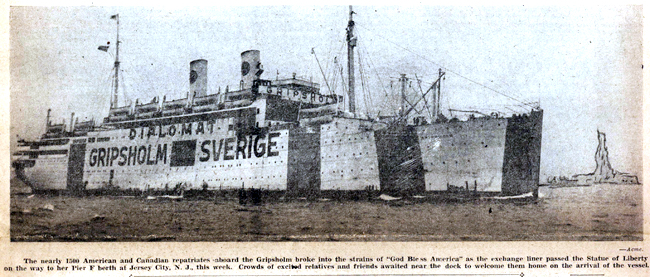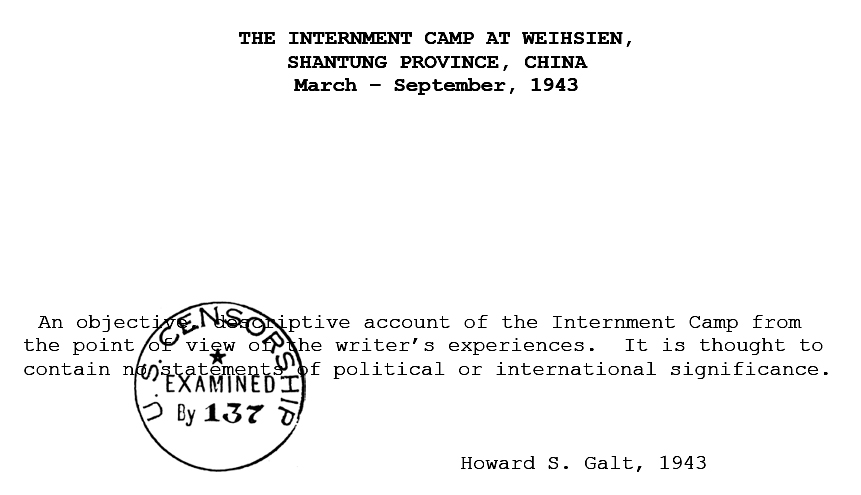
- By Howard S. Galt


Dining
As to general living conditions in the camp,
some accounts, more in detail, of kitchen and dining room arrangements, is in order.
By way of example the conditions in Kitchen No. 3, which served the Peking group, will be considered.
Kitchen No. 3, and its dining room, were housed in the lower floor of a two-story building in dimensions about 80 feet long by 40 feet wide. The kitchen occupied two rooms about 12 feet wide, across the two ends of the building, the central part
being the dining room, and communicating with the kitchen rooms by broad doorways. For the kitchen fires the Japanese had built brick ranges, with grates for either wood or coal, and crowned with large, shallow, open kettles about four feet in diameter. These stove structures, with their big kettles, were essentially in the common Chinese pattern. The kettles were covered with round wooden covers. All processes of cooking had to be adjusted to this equipment. The dining room was supplied with tables and long benches (no chairs) hastily built by carpenters.
The benches were so poorly constructed that they soon began to collapse, and all of them (and those in the other dining rooms also) had to be rebuilt by the camp carpenters.
East and North of the building was a wide open space, partly shaded by trees.
In this area supplies of food and fuel could be unloaded, meat and vegetables could be prepared for cooking, and queues for entrance to the dining room doors could be formed.
The kitchen 3 group was fortunate in having among its personnel a few cooks of almost professional status.
There was an ex-Marine from the American Embassy guard in Peking, a Catholic “Father,” and a group of two or three Dutch nuns.
All of these had had experience in group-kitchen cooking. Assistants were appointed for these and they took charge of the heavy cooking labor in rotation through weekly periods.
Besides the cooks a large staff of women and men were required for specialized tasks. The preparation of vegetables, the pumping and carrying of water, starting the fires, chopping wood, serving in the dining room, washing dishes, washing dining room tables (there were no table cloths) and sweeping the floors, carrying bread and other supplies – nearly all of these tasks required 3-times-a-day attention and effort. Weekly assignment to these tasks, involving perhaps 30 to 75 people, was the responsibility of the employment committee.
As to supplies for the diet, there were only two articles unlimited and always available: white bread and tea, and some of the meals, especially breakfasts, consisted entirely of these two articles. That more meals were not this limited was the result of ingenious planning of the cooks, rather than of the liberality of the Japanese supplies office. We have already mentioned the bakery as a central establishment.
Flour and yeast were often variable in quality and at times the bread was quite inferior. But on the whole, the bread may be rated as good and wholesome. Tea was served without fail three times a day, but there were no “trimmings” to go with it.
Vegetables, next to bread and tea, were the most liberally provided.
Potatoes were quite frequently supplied, but they were usually small and limited in quantity. For the sake of economy they were usually served (and eaten) unpeeled. Cabbages, leeks, onions, and other green vegetables were more liberally supplied.
Meat and fish appeared quite often, and were supplied more frequently than conditions in the cities we had left behind would lead us to expect. Beef and pork were most common, with fish occasionally.
Eggs were issued in very limited numbers to the kitchens, but a larger proportion of people had their own methods of securing eggs (either from the canteen or from the “Black Market”) and special arrangements were made in the kitchen for cooking eggs for individuals.
Fresh fruits, such as apples and pears in season, were issued occasionally to the kitchen in very small quantities. Some sugar and margarine were supplied.
Salt and chiang yu, a Chinese condiment resembling Worcestershire sauce were issued in sufficient quantity.
Considering the limited and rather irregular issue of food supplies by the Supplies Office the cooks seemed remarkably resourceful and ingenious in introducing both variety and palpability into the diet.
The bread and tea menu, which seemed so often indicated by the limited supplies issue, was often varied by making a kind of “bread porridge” out of the dried and leftover residues of the daily bread quota. This breakfast dish was served so often that it came to be called “Weihsien Porridge.” While many people tired of it, to be sure, yet it was a successful effort to make much out of little.
For the other meals the chief dish was usually a rich soup or a stew to which, in order to achieve nourishment and variety, all the ingredients in the days issue of supplies were added.
One reason for putting most of the meal into a single soup or stew was the manner of service.
Everyone had to supply his own dishes, carrying them to and from the dining room for each meal.
With the number of dishes by this condition reduced to a minimum one large bowl or one deep plate was the most common equipment.
Not only so, but speed in the serving process, with long queues waiting was important, and one large unit of food was most convenient. Economy in dish washing was also an important factor.
The food was served just inside the door from large containers brought steaming hot from the kitchen.
As soon as served, people found their places at the tables, having mastered the art of climbing or hopping over the long benches already placed at the tables.
In doing so, if you managed to kick only one of your neighbors already seated you were considered quite polite.
At the table were found plates or trays of bread – frequently replenished by waiters appointed for the purpose. Another set of waiters poured tea or hot water or both as required.
Besides these two types of floor waiters there was a third, a woman who went about with a cloth wiping the table after persons had finished, in preparation for the next to follow.
If the food for a meal was sufficient second helpings could be had by those with more hearty appetites.
A second helping was usually served from a well-recognized extra container in the corner of the room, and was often announced orally by persons in charge, the formula being, for example “Seconds on stew!” For such an announcement, or for any other, to be made, there must first be a sharp table-rapping to silence the noise and secure attention. The talking and clatter in a dining room of 110 or 200 people reminded one of the noise of conversations in a large institutional reception, when everyone has to raise his voice to be heard.
Dish washing was a carefully systemized process.
There were two or three units of operation, each in charge of one woman or sometimes two.
For each unit there were two large containers of hot water, one for washing and one for rinsing.
When people had finished a meal they “queued up” before one of these units, handed in their dishes (after each person, urged on by public notice and public opinion, had made them as clean as possible as he finished the meal) and received them again out of the rinsing pail.
There was no dish wiping except as some of the more particular arranged to do it for themselves.
Although for the fastidious feeders and delicate diners, people who ordinarily make much of the aesthetic aspects of eating, the meals were not attractive, yet on the whole they were fairly nourishing and wholesome.
There was a monthly weighing schedule, arranged by some of the physicians as a check on diet.
The monthly weight records showed that, after the first few weeks, gains and losses of weight were somewhat evenly balanced.
This good result of diet should no doubt be credited in part to purchases of food from the canteen, rather than to the adequacy of the dining room diet.
After the first month or so the canteen was provided with more adequate snacks, so that eggs, fresh fruit, honey and some other articles were available for purchase.
With most of these commodities, however, the supply was limited, so that a system of rationing and systematic distribution had to be adopted. At first this meant long lines in queue, but later, after the system of wardens was adopted, the distribution was usually through the wardens, and long periods of waiting were unnecessary.
#
[further reading] ...copy/paste this URL into your Internet browser:
http://www.weihsien-paintings.org/DonMenzi/ScrapBook/1943-Galt_Weihsien-1.pdf
#








